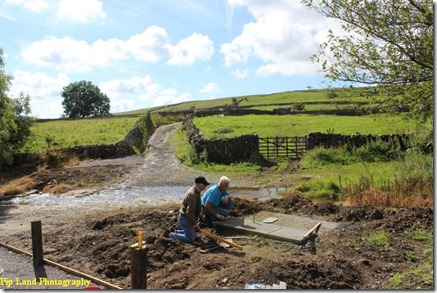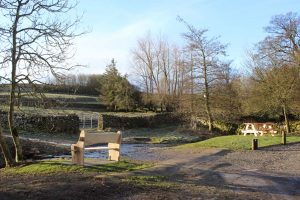The Outgang at Thornton Rust is the perfect place to start a walk along the bridleway to Thornton Rust Moor and then, via a permissive footpath, to the site of an ancient settlement at the top of Addlebrough. For those who don’t want to go so far it is but a gentle walk up to the old lime kiln and into the Kennel Field where there is a seat overlooking the village. (Above: preparing the site for a picnic bench, with the bridleway on the other side of the beck. )
During the summer of 2017 some of the villagers have worked very hard to create a new car parking area at the Outgang and in doing so revealed features of the village’s agricultural and social past. (Click on the picture to see more photos of the work at the Outgang. )
They were grateful for a grant from the Yorkshire Dales National Park Authority’s sustainability fund which will also cover the cost of preparing and installing an interpretation board. This will show how West Beck was dammed each year up until the beginning of the 20th century to form a pond where sheep could be washed to remove salve and lanolin before being clipped.
The salve, according to Eleanor Scarr, was a mixture of rancid butter and tar which helped to stop the sheep being struck by flies. In this year’s Now Then (the annual magazine of the Friends of the Dales Countryside Museum) there is an interview with her and her brother, Owen Metcalfe, about how farmers like their father, Sidney Metcalfe, used the beck – and how, on a hot summer’s day they would dam it so that the children could play in the water. Copies of the magazine are on sale (£2 each) at the museum in Hawes.
Below: the benches installed in December 2017
Ecologists congratulate the villagers
In November 2017 Deborah Millward wrote:
Last month I led a group of ten ecologists a short walk round the village. We discussed the West End Bank, which had just been cut and cleared, much to their approval.
I then showed them the new car park area up the Outgang describing the morass of docks and ground elder that had previously featured there. The consensus was that even if the “dreaded weeds” had not been defeated, the eventual increase in biodiversity was worth the effort. They greatly appreciated the improved facilities.
In East Lane I explained the problems we had experienced with water eroding the track. The new drain, funded by the Parish Wildlife Scheme, had gone in and the track could be restored. The Catchment Sensitive Farming Scheme was a possible source of funding for keeping silt out of the stream.
We discussed how best to manage the grazing to protect the flower-rich sections. Their advice was to graze in the autumn with cattle to remove the bulk of the year’s growth, then to follow this with sheep at some time in the winter months.
In the Kennel Field I showed them photos of the site before work started almost 20 years ago. The present day scene of trees and honeysuckle created a good impression, especially with the RSPB person. Sadly I had to report that black grouse no longer used the field’s hawthorn trees. The group were full of praise for the effort villagers were making to conserve and restore wildlife and wished us luck with East Lane.

